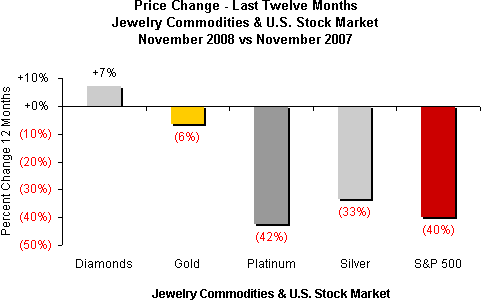IDEX Online Research: Diamond Prices Hold Up While Jewelry Commodities Fall
December 03, 08
Diamantaires may be complaining that polished diamond prices are softening, but diamonds have been the “place to be” in today’s uncertain economic environment. IDEX Online Research compared polished diamond price performance over the past year to other jewelry commodities – gold, silver, platinum – and the U.S. stock market as measured by the S&P 500, a broad market indicator.
Diamonds are the only commodity used in the jewelry industry with prices that are still above last year’s level. When compared to the U.S. stock market, diamonds have dramatically outperformed equities.
The graph below compares twelve-month price changes for major jewelry commodities and the U.S. stock market to diamond prices.

Source: Markets
Forecast: Polished Diamond Prices Likely to Decline Near Term
The inflation flames related to polished diamond price have been snuffed out. Polished diamond prices rose at unrealistic rates in the first half of the year; we do not foresee this trend in the second half of 2008.
There is too much uncertainty related to the global economic situation to fuel continued diamond price inflation at the unusually high rates earlier this year.
After a strong first half, economic growth in the U.S. as measured by Gross Domestic Product (GDP) finally slid into slightly negative territory – 0.3 percent down – for the third quarter ended September 30, 2008. The National Bureau of Economic Research, the sole body which determines when the U.S. enters and exits a recession, has declared that the American economy has been in a recession since December 2007. Most economists are predicting another quarter, at least, of modestly negative economic growth. The media has whipped consumers and businesses into a frightened frenzy, and put them into a mental recession which could be worse than the numbers indicate.
In an effort to keep the world’s economies from slipping further into recessionary territory, central banks worldwide are pumping money into their economies. This should help credit market liquidity and stimulate growth. The U.S. government has been the leader in attempting to blunt the impact of a recession, and it appears to have had a somewhat stabilizing impact on the economy.
Unfortunately, consumers have been particularly hard-hit. Both real estate and stock prices are down. These two categories are typically shoppers’ largest asset categories. When consumers feel less wealthy, they tend to tighten their purse strings.
Oil prices have retreated, so consumers’ pocketbooks won’t be as pinched, as we head into the holiday selling season. This could help maintain demand for discretionary goods such as jewelry.
Our forecast calls for diamond prices to drop another 4-5 percent in December, until they hit the long term trend line for price inflation – about +3-4 percent annually. However, it is highly likely that polished diamond prices will drop further in subsequent months, until consumer demand stabilizes.
If the diamond markets operate on the basis of capitalism, then demand and supply should help stabilize diamond prices as they retreat toward their historic inflation rate. Unfortunately, life doesn’t work that way. For example, oil was unrealistically priced at $140 per barrel; it is predicted to fall to near $40 per barrel. Neither the high nor the low prices of oil reflect true supply and demand, which some analysts see as stabilizing at $60-70 per barrel.
Likewise, diamonds could drop to unrealistically low prices before stabilizing and recovering sometime in 2009. While capitalism – and its inherent supply and demand – isn’t perfect, no one has come up with a better, more successful long term alternative.